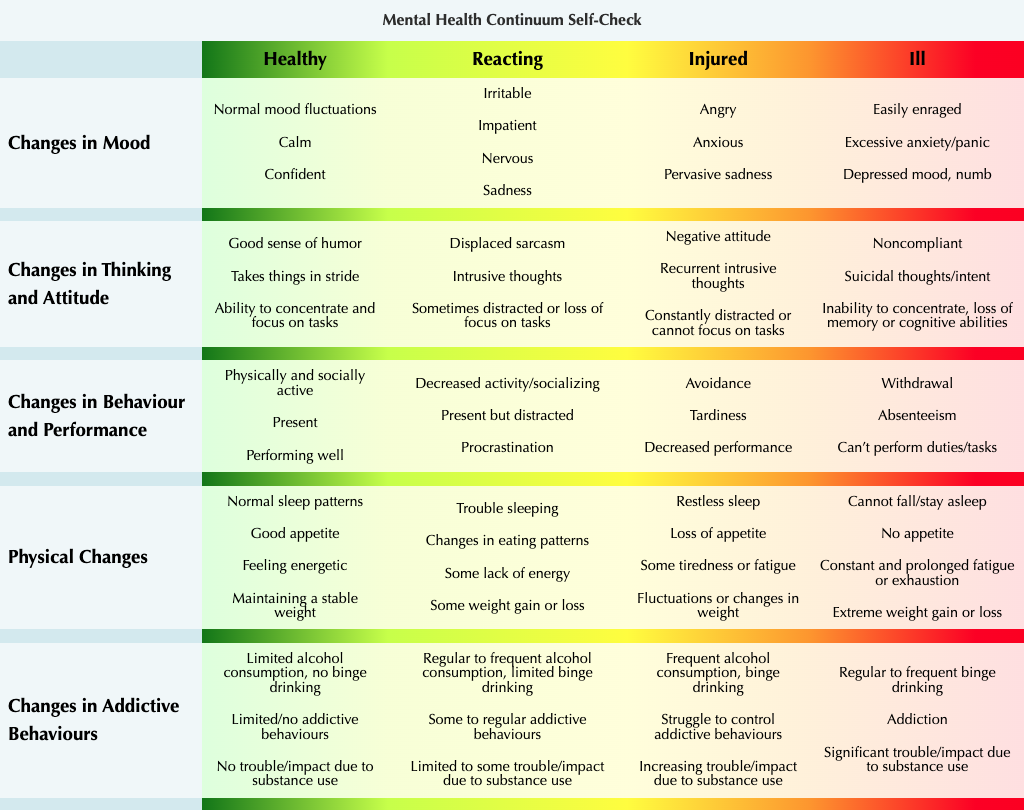2.Understanding Our Mental Health
Understanding Our Mental Health
Understanding Our Mental Health (1:29)
-Hayley Peek & Kim Sunderland, Supporting Through Struggle™
 You may be familiar with the statistics when it comes to mental health, we are inundated with these numbers. The prevalence is clear, 1 in 5 Canadians will experience a mental illness or addiction problem, and by the time Canadians reach 40, 1 in 2 have or have had a mental illness1. Moreover, young adults aged 15-24 are more likely to experience a mental illness and/or a substance use disorder than any other age group2.
You may be familiar with the statistics when it comes to mental health, we are inundated with these numbers. The prevalence is clear, 1 in 5 Canadians will experience a mental illness or addiction problem, and by the time Canadians reach 40, 1 in 2 have or have had a mental illness1. Moreover, young adults aged 15-24 are more likely to experience a mental illness and/or a substance use disorder than any other age group2.There are a variety of factors that can lead someone to experience a mental illness, and these statistics are only what is reported. Mental health is something we all have, whether we have a clinical diagnosis or not. It’s important to know that mental health is something that requires all of us to care for.
The reality of what we are currently seeing in postsecondary students is:
- 75% Percentage of mental-health problems that appear before the age of 25
- 46% Percentage of postsecondary students who reported in 2016 feeling too depressed to fully function, up from 40% in 2013
- 65% Percentage of postsecondary students who in 2016 reported overwhelming anxiety, up from 58% in 20133
Our mental health includes our thoughts, actions and emotions and how they interact with each other in our day-to-day life. There may be days where we feel the ability to focus, cope with stressful situations and enjoy our regular social activities. We may also have days where these things can feel challenging for a variety of reasons. Good mental health isn’t just the absence of a mental health challenge or illness; it is our ability to cope and move through difficult times without reaching a state of burnout. Some good indicators of how we measure our mental health can include how we function and build relationships, our ability to bounce back from difficult situations (resilience) and how we navigate hardship and challenges in life.
Knowing how to recognize the difference between mental health and mental illness, it is important to gain understanding of the facts of mental illness. Here is a link to credible information from the Canadian Mental Health Association on Understanding Mental Health.
The Mental Health Continuum Model
The Mental Health Continuum Model (1:18)
Regardless of whether one lives with an illness or not, it is critical that we recognize the signs and how our mental state can shift depending on life experiences and situations. To better understand this concept, we are going to look at the Mental Health Continuum4.

Image Source: © 2018 Mental Health Commission of Canada
If we look at the Continuum, we can visually see that mental health is not linear, but fluid. Our mental state changes day by day where our experiences may impact our health, leading to a variety of symptoms.
It is strongly recommended that you make this continuum available to yourself and your team and practice checking in on where you find yourself. By using this model, it can assist in learning how to recognize early warning signs of a mental health challenge, normalize the conversation of mental health and look to support yourself or others facing challenges.
Mental Health in the Workplace: Understanding Stress Versus Anxiety
Understanding Stress and Anxiety (1:05)
Although stress and anxiety can reflect many of the same signs and symptoms, they are in fact different. Stress is caused by external factors and is our response to situations (both good and bad) while anxiety lies internally. At some point or another, we all experience stress; it is an expected part of everyday life. This can be in response to taking on too many obligations at work or in our personal lives, meeting timelines, travelling somewhere new or attending a social function. It’s important to be aware, however, that long-term stress can become detrimental and lead to mental health challenges including anxiety, depression, sleep problems, physical pain and in some cases, substance use issues.
Here are two resources, one for stress and one for anxiety, for some examples of physical, cognitive, and emotional reactions for each. Please note, this is in no way an exhaustive list of all signs and symptoms of stress and anxiety.
CAMH resource for signs of stress: https://www.camh.ca/en/health-info/mental-illness-and-addiction-index/stress
CAMH resource for signs of anxiety: https://www.camh.ca/en/health-info/mental-illness-and-addiction-index/anxiety-disorders
Stigma
What is Stigma? (2:28)
“There are many reasons why people develop mental illness. Some are genetic or biological. Some are a result of childhood trauma or overwhelming stress at school, work or home. Some stem from environmental injustice or violence. Sometimes, we simply don't know. Regardless of the reasons, these are health problems just like cancer, arthritis or diabetes. So why does society look at people with mental illness, including substance use disorders, differently?
The answer is Stigma. The real question, however, is how do we stop it?”
What is Stigma?
Before we can address how to refrain from stigmatizing language, beliefs and behaviours, we need to understand what stigma is. Let’s begin by watching this eye-opening video created by IWK Health Centre and the Mental Health Commission of Canada (MHCC).
When we label, judge or treat others differently due to physical, mental or socio-economic realities as some examples, we contribute to stigma. Stigma is all around us and sometimes we even contribute to it unintentionally. So, how can we become more aware of stigma and adopt practices to avoid it when we talk about mental health?
Paying Attention to Labels and Language
When we use illnesses as adjectives to describe someone struggling (as we can see through this illustration), we contribute to stigma.
These are words that hold negative connotations such as alcoholic, schizophrenic, or crazy. Becoming more aware of the words we use can help reduce stigma. For example, instead of referring to someone as ‘an alcoholic’, we would say, ‘someone with substance use issues’. Our words can have a big impact in our conversations; the more aware we become, the more we learn about ways to reduce the use of stigmatizing language.
For further learning on Stigma, it is encouraged to take this free online course hosted by Centre For Addiction and Mental Health (CAMH)
Activity One: Reflection
In your Managing Stress and Mental Health Instructor Workbook, complete the following reflection questions.
Question 1: When you look at the Mental Health Continuum Model (above), where are you finding yourself at this moment (today, this week, this month)? Have you noticed yourself moving back and forth between green, yellow, orange and perhaps even red?
Write down a few points about how you recognize where your own mental health is currently.
Question 2: How can you tell when you are under stress? Use the table below to note how you carry stress in your body. What might you feel, think, experience?
Physically | Mentally | Emotionally | Other |
| Ex. I experience a rapid heart beat | Ex. I feel mentally exhausted and find it hard to concentrate | Ex. I get irritated easily | Ex. When I am stressed, I have a hard time prioritizing tasks |
Question 3: How can you, as a leader, bring the conversation of stigma into your team? Consider ways that this topic can be discussed in an open and safe manner and how you can grow your awareness of reducing stigma in the workplace.
Viewed 4,350 times